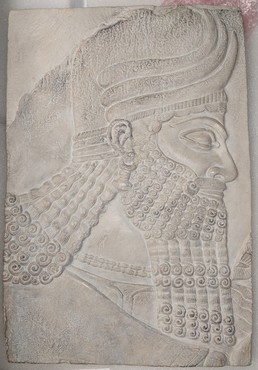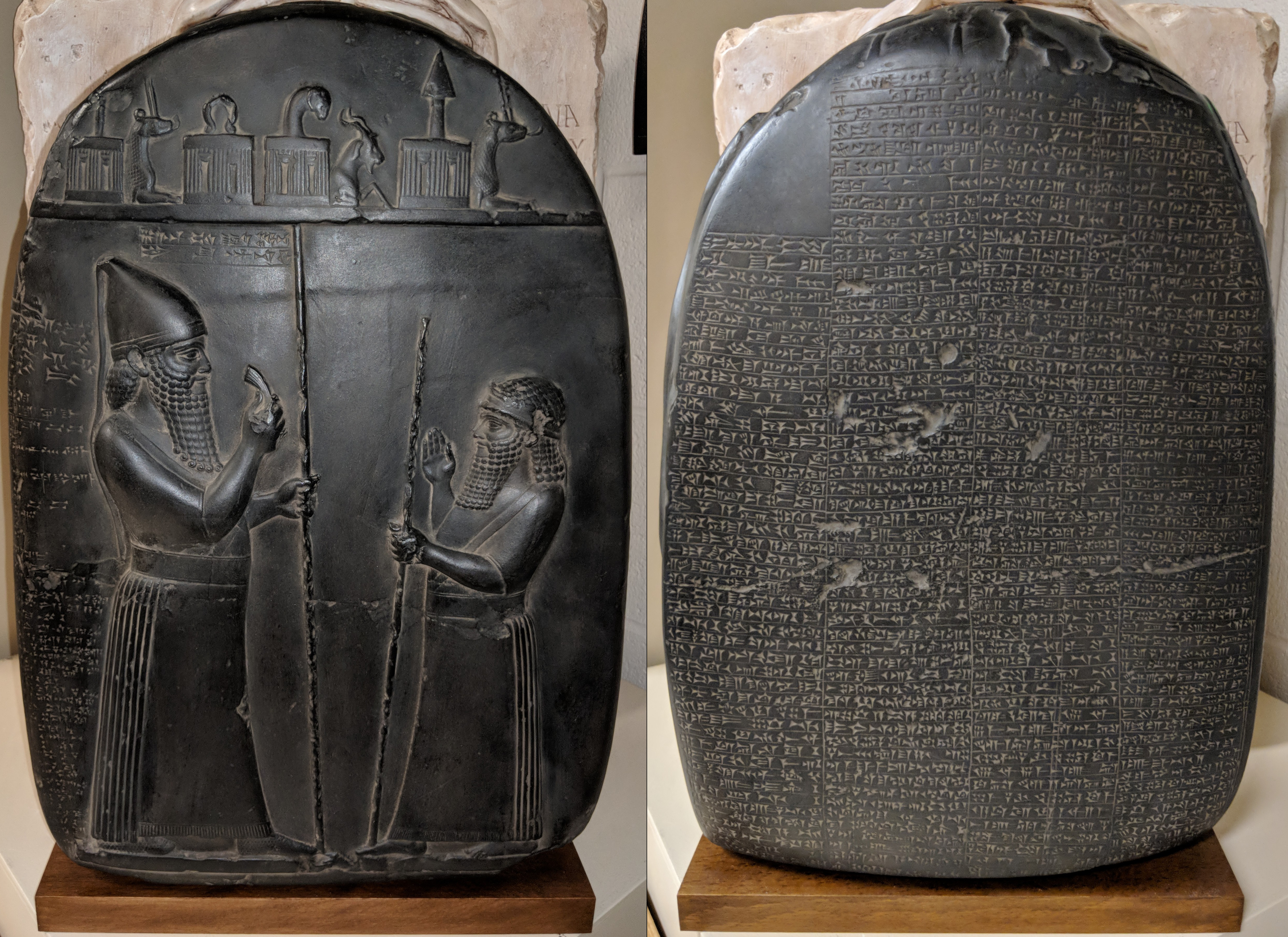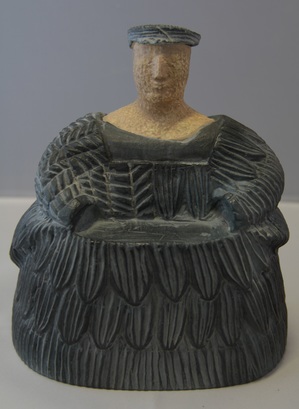Recent Acquisitions
Head of a Genius

Head of a Genius
Near Eastern (Assyrian)
replica: from the Gipsoformerei, Berlin
medium: plaster; alabaster original
gift of: the Nasser Family
date of the original: c. 883 - 859 BCE
provenance of the original: Palace of Kalhu, Kalhu (modern Nimrud), Iraq; now in the Pergamonmuseum, Berlin
description: This relief of a genius, or protector demi-god, originates from the reign of Ashurnasirpal II, an Assyrian king whose success came from his numerous campaigns, his military leadership, and diplomacy. This specific relief was found in the king’s palace in Kalhu, and was one of many such reliefs that decorated the palace walls. Genii were anthropomorphic supernatural beings, but they also could be represented as animal hybrids with the heads of eagles. They often had wings and were considered protective deities, particularly with respect to royalty, which explains their frequent depiction in palaces.
Presumed Head of Hammurabi

Presumed Head of Hammurabi
Near Eastern (Babylonian)
replica: from the Louvre, Paris
gift of: the Nasser Family
medium: plaster; diorite original
date of the original: early 2nd millennium BCE
provenance of the original: Susa (modern Shush), Iran;
now in the Louvre, Paris
description: This presumed portrait head of the Babylonian king Hammurabi (1792-1750 BCE) was once part of a full-length statue. the type of headdress and the artistic style in which the hair and beard are carved allows art historians to date this statue to the era of Hammurabi or just prior. Despite the naturalistic expression and aged facial features, it is difficult to pinpoint the identity of the figure. Hammurabi’s fame is due in large part to his detailed law code, which predates Biblical law, and he is recognized for ushering in the beginning of Babylon’s political rule over southern Mesopotamia.
Boundary Stone With Inculcation Ceremony

Boundary Stone With Inculcation Ceremony
Near Eastern (Babylonian)
replica: from Gipsoformerei, Berlin
gift: of the Nasser Family
medium: plaster; limestone original
date of the original: end of the 8th century BCE provenance of the original Likely Susa (modern Shush), Iran; now in the Pergamonmuseum, Berlin
description: This kudurru, or boundary stone, was excavated at Susa in 1912 along with several other such stones. Depicted on this kudduru are the Baby- lonian king Marduk-apla-iddina II and his loyal vassal Bel-ahhe-eriba, to whom the king grants land. Above them are symbols of various gods such as Marduk (a snake-dragon), Ea (goat-fish and/or ram’s head), and Nabu (a wedge and snake-dragon), who witness and guarantee the legal transaction carved in the extensive cunei- form text that appears on the sides and the back of the kudurru. Kings would often gift land to vassals in order to ensure their loyalty to his rule.
Woman Holding An Aryballos

Woman Holding An Aryballos
Near Eastern (Sumerian)
replica: from Louvre, Paris
gift: of the Nasser Family
medium: plaster; alabaster original
date of the original: 2114 - 2004 BCE provenance of the original Girsu (modern Tello), Iraq; now in the Louvre, Paris
This beautiful statuette was created during the Third Dynasty of Ur, which was known as the ‘Sumerian Renaissance’, a period in which Sumerian art and literature began to flourish. This portrait exemplifies a desire by artists to depict the subject in a more realistic way. She is seated with her feet close together while holding an object, here a perfume vessel called an aryballos, which was perhaps used in ritual offerings and prayers to the gods.
Although the woman presented in this portrait is of high status, it is not clear who this woman is. She could be princess Enanatuma, who was also a priestess and representative of the goddess Ningal during ritual activity. Ningal was the wife of the moon god Nanna and the mother of the sun god Utu.
A ‘Princess’ of Bactria

A ‘Princess’ of Bactria
Near Eastern (Bactrian)
replica: from Louvre, Paris
gift: of the Nasser Family
medium: plaster; calcite and steatite original
date of the original: late 3rd to early 2nd millennium BCE provenance of the original Bactria-Margiana Complex, Afganistan; now in the Louvre, Paris
Bactria was located in modern day Afghanistan and was a wealthy state due to their exchange of raw materials with Mesopotamia. This elegant statuette of a women in an elaborate dress was one some forty such figures found throughout Bactria and are commonly referred to as “Bac- trian princesses.”
While most “Bactrian princesses” are depicted seated, this one is shown standing and is a slightly larger size than the others. Her dress is quite striking and full, sculpted from green- ish-grey steatite and represents a kaunakes, a Sumerian style of skirt made of tufts of wool, here having the appearance of leaves. It has been speculated that these objects represent a female divinity, although no definitive proof has been found to support this claim.
Gilded Silver Vessel

Gilded Silver Vessel
Near Eastern (Late Sasanian/Early Islamic)
replica: from Gipsformerei, Berlin
gift: of the Nasser Family
medium: resin; gilded silver original
date of the original: 601 - 800 CE provenance of the original found in Russia, likely produced elsewhere; now in the Pergamonmuseum,
This vessel has a small puncture near the base used to strain haoma, the sacred vine important in Zoroastrian religion. The source of haoma is the Iranian Tree of Life, identifiable by the attached vines. Sprigs of the haoma were brought to earth by divine birds, represented here as large cranes. The left-facing crane seems to be characteristic of early Islamic work, as right-facing images were typical of the Sasanian period.
The Tree of Life was planted alongside another tree called the Impassive, represented on the opposite side of the vessel. The Impassive tree bore fruit containing the seeds of every kind of plant including the extending typha reeds (cattail). The lower vines encircle two small birds, ready to carry the fallen seeds to the rain god Tištrya to purify the lands and bestow fertility.
The iconographic result of the vessel depicts natural harmony and the existence of freedom in nature.